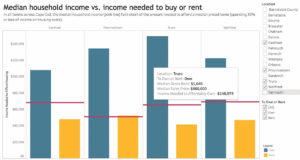PROVINCETOWN — The first tranche of data from the 2020 U.S. census was released last week, and it shows something new for the Outer Cape: substantial population growth.
The 2010 census showed the resident population here falling relative to the 2000 count. Provincetown had lost 14 percent of its population in 10 years, as of 2010, and Eastham had lost 9 percent.
Now, the 2020 count shows all four Outer Cape towns rebounding well beyond their 2000 numbers. In fact, the growth rate in Wellfleet was the highest in mainland Massachusetts, with the exception of tiny Tyringham in the Berkshires, which went from 327 people to 427. Wellfleet grew by 29.7 percent — from 2,750 people to 3,566.
Provincetown grew from 2,942 people to 3,664 — a growth rate of 24.5 percent. Truro’s population grew from 2,003 to 2,454, an increase of 22.5 percent. And Eastham grew from 4,756 people to 5,752 — a jump of 16.1 percent.
No other town on Cape Cod came close to these numbers in percentage terms. Nantucket and Martha’s Vineyard, however, both outstripped even the Outer Cape. Nantucket’s population grew an astonishing 40 percent in 10 years, from 10,172 people to 14,255. Dukes County, which contains all six towns on Martha’s Vineyard, grew 24.6 percent, from 16,535 people to 20,600.
The scale of these numbers raises many questions. Was the 2010 census an undercount? Was the 2020 census an overcount because there were so many people taking refuge here from Covid?
Officials on Nantucket have argued the 2010 census undercounted their island’s population. People on the Outer Cape have tended to accept that the year-round population here is shrinking. And, indeed, it could have continued to shrink all the way through 2019, before rebounding during the pandemic.
But it’s hard to pin the entire increase on Covid. The census specifically asks where you were living on April 1, 2020. “You should respond for the address of your usual residence (which is the place where you live and sleep most of the time) as of April 1, 2020, even if you were temporarily staying elsewhere on April 1, 2020,” said the instructions. People who relocated to their second homes early in the Covid pandemic would theoretically still have filled out census forms for their primary address — even if they were completing those forms in July or August of 2020.
These instructions notwithstanding, by July or August some people may have decided their move here was permanent. Given the sheer scale of the increase, though, it seems unlikely to be the only cause.
Race and Age
Last week’s release included data on race, but not much data on age. In Provincetown, the Black, Asian, and Hispanic-origin populations all climbed even faster than the overall rate of growth. Provincetown is still overwhelmingly white — but it went from 92 percent white to 86 percent.
The same patterns are seen in Wellfleet, Truro, and Eastham, which all now have white populations around 90 percent. In Eastham, the 2010 census counted only 34 Black residents, while the 2020 census found 190.
The only age data available comes indirectly, by comparing total-population numbers to 18-and-over population numbers. Here, the news is less good. Provincetown’s under-18 population actually fell, from 167 people in 2010 to 153 in 2020. The same thing happened in Truro: 263 minors in 2010, and only 248 in 2020.
In Wellfleet, though, the under-18 population went up, from 369 to 394, a 7-percent increase. And in Eastham, the under-18 population went from 627 to 652, a 4-percent increase.
Even in those two towns, though, the percentage increase in the under-18 population was much smaller than the percentage increase in the overall population. The Outer Cape has definitely gained people, but the numbers suggest it is still disproportionately not gaining families with children.
Housing
Provincetown also gained 489 units of housing overall — something the other towns definitely cannot say. Provincetown’s total housing units (a number that includes both year-round-occupied and seasonally vacant residential units) went up almost 11 percent in 10 years.
Eastham gained 145 residential units, good for a 2.5-percent increase over 10 years.
Wellfleet and Truro, however, actually lost residential housing units.
The 2020 census counted 76 fewer places to live in Truro than there had been in 2010 — a 2.5-percent decrease. Wellfleet, meanwhile, lost 42 residential units over ten years, a decrease of 1 percent.
A 29.7-percent increase in population and a 1-percent decrease in housing units is a stunning combination for Wellfleet. The Outer Cape has always been a literal, as well as a metaphorical, outlier; this decade’s census data simply drive home the point.



